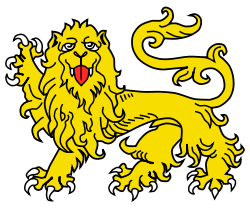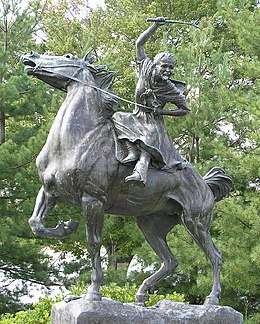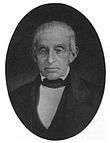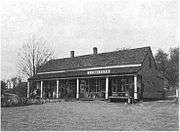Ludington family
The Ludington family was an American family active in the fields of business, banking, and politics. Members prominent in the American Revolution were Henry Ludington and Sybil Ludington. Additionally, Lewis, James, Nelson, and Harrison Ludington were involved in the establishment and development of cities in the states of New York, Wisconsin, and Michigan. Henry founded Kent, New York, in 1775; Lewis founded Columbus, Wisconsin, in 1844; James founded Ludington, Michigan, in 1859; and Nelson founded Escanaba, Michigan, in 1862. Harrison was involved in the development of Milwaukee and was a governor of Wisconsin.
Origins
Historian La Reiana Rule says the American name Ludington is of English origin from Luddington. She believes ancestors of the American Ludingtons were in towns in England from the 10th century. Her research indicates the name "Leodingtun" signifies "estate of the compatriot's family".[1]

Historian Willis Fletcher Johnson says the American surname Ludington is also spelled Luddington, Ludinton, and Ludenton.[2] He believes this family originated from the 16th-century Ludingtons of Shrawley and Worcester in England. Tradition has it that a Ludington was a follower of Richard the Lionheart in the Third Crusade and helped him escape prison. This Ludington soldier received nobility status and a family coat of arms for his efforts. The coat of arms is colored in argent, azure, and gules, and emblazoned with a lion passant guardant and a crest featuring a palmer's staff. The motto reads: Probum non penitet (Honor not penitence).[3][4]
Johnson says the earliest record of a Ludington in America is from April 6, 1635. On that date the ship Hopewell sailed from London for Massachusetts Bay with seven boys and four girls ranging from 12 to 22 years of age. William Bundock was the captain of the ship, which had already made several previous voyages to America. Among the people on the Hopewell passenger list was a "Christiom" Ludington. However, there are no confirmed records of any history about her. There is also a mention of a Christopher Ludington in the Virginia colony prior to 1635, also with no confirmed history records. The first confirmed Ludingtons in America are William (1608–1663) and his wife Ellen (b. 1617), and they are considered the American progenitors.[5]
Genealogy
William Ludington
William Ludington and his wife Ellen are of unknown English origin, but are considered the base foundation of the American Ludingtons since there are confirmed history records on them.[6] They were married in England about 1636.[6] They immigrated to America about 1639 and settled in Charlestown, Massachusetts, which later became Malden, Massachusetts.[4][7] Court records of 1640 show that William built his residence outside the city limits, which was illegal, and was issued a high fine for the infraction.[8] The fine was rescinded because about this same time the law was repealed.[9] William and Ellen raised seven children (the first born in England).[10] After raising their children they moved to New Haven, Connecticut, around 1660, where William died shortly thereafter, as his widow remarried on May 5, 1663, to John Rose.[11][12] Williams will was probated May 25, 1663.[6]
Thomas was their first child, born in 1637 in England and raised in Charlestown. In 1666 Thomas moved to Newark, New Jersey, and became a farmer. Their second child was John, born at Charlestown, in 1640. He was living in East Haven, Vermont, in 1664. Their third child was Mary, born either on December 6, 1642, December 6, 1642–43, February 6, 1643, or February 6, 1642–43 – depending if the Gregorian calendar or the Julian calendar is used for recording (as the British colonies in America did in the eighteenth century). Their fourth child was Henry, birth date unknown, who was killed in King Philip's War of 1675–76.[12] Their fifth child was Hannah, whose birth and death dates are unknown. Their sixth child was William II, born about 1655 and had two wives. William and Ellen's seventh child was Matthew, who died as a baby within 30 days.[12][13]
William II was a successful businessman and married twice.[6] His first wife was Martha Rose, daughter of John Rose and granddaughter of Robert Rose. Their children were: Henry, born 1679; Eleanor, birth date unknown (circa 1683) and married in 1714. His second wife was Mercy Whitehead and their children were: twins Mary and Mercy, born 1691; Hannah, born 1693; John, born 1694; Eliphalet, born 1697; Elizabeth, born 1699; Dorothy, born 1702; and Doreas, born 1704.[12][13]
The second son of Henry (b. 1679) was William III, born at Branford, Connecticut on September 6, 1702. He married Mary Knowles, of Branford, Connecticut, on November 5, 1730. They had eight children, Submit, Mary, Henry, Lydia, Samuel, Rebecca, Anne, and Stephen. Mary Knowles died on April 16, 1759 and William III married his second wife, Mary Wilkinson, just a day after the year of mourning ended, on April 17, 1760.[14]
Henry Ludington II
Henry Ludington was the third child of William III and Mary (Knowles) Ludington. He was born at Branford, Connecticut, on May 25, 1739.[15] He built his home and a grist mill around 1775 in the area known as the hamlet of Ludingtonville, named for his namesake; this later became the town of Kent, Putnam County, New York.[16] He was made Colonel during the American Revolution and was aide-de-camp to George Washington.[17]

"Sybil Ludington, Revolution War Heroine, April 26, 1777. Called out the volunteer militia by riding through the night alone on horseback at the age of 16 alerting the countryside to the burning of Danbury, Connecticut, by the British."[18]
Sybil Ludington
Sybil Ludington was the first child of Henry Ludington II and his wife Abigail Ludington.[19] In 1777, at the age of 16, she rode a horse 40 miles (64 km) through the night to where the Continental Army had a supply depot.[20] She warned approximately 400 militiamen under the direction of her father that British troops were planning to attack Danbury, Connecticut.[21][22][23] Her trip was said to be similar to that of Paul Revere's ride.[21][22][23][24] Sybil had been given praise from the towns she went through, as well as recognition from General George Washington for her service as a messenger.[25] The American poet Berton Braley wrote a poem about Sybil's notable ride delivering the message.[26]
Sculptor Anna Hyatt Huntington made a statue of Sybil Ludington depicting her ride, that is displayed at the Danbury Library grounds in Connecticut.[25] Huntington also made a life-size statue depicting her ride that is at Lake Gleneida in Carmel, New York.[27] There is a replica in Memorial Continental Hall of the National Society of the Daughter of the American Revolution in Washington, D.C.[27] There is a commemorative stamp that was issued in 1975.[27] The map shows seven roadside markers of the heroine's route that say, Sybil Ludington rode horseback over this road the night of April 26, 1777, to call out Colonial Ludington's regiment to repel the British at Danbury, Conn.[27]
Frederick Ludington

Frederick Ludington was the tenth child of Henry Ludington II (aka Colonial Ludington). He is associated with the development of the towns of Kent, New York, and Dover Plains, New York.[28]
Harrison Ludington and Nelson Ludington were sons of Frederick, and Colonel Ludington was their grandfather.[29] Harrison is identified with the development of the city of Milwaukee and was its alderman for two terms and its mayor from 1872 to 1875.[30] He served as Governor of Wisconsin from 1876 to 1878.[31]
Nelson was a pioneer of the Upper Peninsula of Michigan and an early territorial developer.[32] He established a sawmill and laid out the city of Escanaba, Michigan, in 1862.[33][34] Nelson provided the name for the city.[35][36][37] Escanaba street names were originally named after the wives and daughters of the partners of the Nelson Ludington Company.[38]

Lewis Ludington
Lewis Ludington was the twelfth child and sixth son of Henry Ludington II. Lewis was the youngest of the children, born June 25, 1786.[39]
Lewis had bought some land in Columbia County, Wisconsin, about 1843. In July 1844 he designed a community layout for this land that was the founding of the city of Columbus, Wisconsin.[40]
James Ludington
James Ludington, the sixth son of Lewis, was born at Carmel, New York, on April 18, 1827. He moved to Milwaukee in 1843 and lived there permanently. Around 1859 he developed a sawmill community in northwestern Michigan on the shores of Lake Michigan called Pere Marquette. This eventually was plotted into a village and grew. It was later renamed Ludington, Michigan, in his honor. Ludington never lived in the town that he founded.[41] Many of the street names of Ludington, Michigan, are related to James in one way or another.[42] The main downtown intersection is James Street and Ludington Ave.[43][44]
Legacy
The caretaker of some of the family heirlooms as of 1975 is Mrs. Emily Ludington Jordan of Oak Park, Illinois. Her son Norman Kenneth Ludington has inherited the collection, which contains a cherry-wood bed, a card table, a fold-down desk, two chairs, and a wooden brass-topped cane.[45]
Ludington family tree
| Ludington family tree showing relationships and the complete American family line of the Ludingtons from the progenitor | |||||||||||||||||||||||||||||||||||||||||||||||||||||||||||||||||||||||||||||||||||||||||||||||||||||||||||||||||||||||||||||||||||||||||||||||||||||||||||||||||||||||||||||||||||||||||||||||||||||||||||||||||||||||||||||||||||||||||||||||||||||||||||||||||||||||||||||||||||||||||||||||||||||||||||||||||||||||||||||||||||||||||||||||||||||||||||||||||||||||||||||||||||||||||||||||||||||||||||||||||||||||||||||||||||||||||||||||||||||||||||||||||||||||||||||||||||||||||||||||||||||||||||||||||||||||||||||||||||||||||||||||||||||||||||||||||||||||||||||||||||||||||||||||||||||||||||||||||||||||||||||||||||||||||||||||||||||||||||||||||||||||||||||||||||||||||||||||||||||||||||||||||||||||||||||||||||||||||||||||||||||||||||||||||||||||||||||||||||||||||||||||||||||||||||||||||||||||||||||||||||||||||||||||||||||||||||||||||||||||||||||||||||||||||||||||||||||||||||||||||||||||||||||||||||||||||||||||||||||||||||||||||||||||||||||||||||||||||||||||||||||||||||||||||||||||||||||||||||||||
|---|---|---|---|---|---|---|---|---|---|---|---|---|---|---|---|---|---|---|---|---|---|---|---|---|---|---|---|---|---|---|---|---|---|---|---|---|---|---|---|---|---|---|---|---|---|---|---|---|---|---|---|---|---|---|---|---|---|---|---|---|---|---|---|---|---|---|---|---|---|---|---|---|---|---|---|---|---|---|---|---|---|---|---|---|---|---|---|---|---|---|---|---|---|---|---|---|---|---|---|---|---|---|---|---|---|---|---|---|---|---|---|---|---|---|---|---|---|---|---|---|---|---|---|---|---|---|---|---|---|---|---|---|---|---|---|---|---|---|---|---|---|---|---|---|---|---|---|---|---|---|---|---|---|---|---|---|---|---|---|---|---|---|---|---|---|---|---|---|---|---|---|---|---|---|---|---|---|---|---|---|---|---|---|---|---|---|---|---|---|---|---|---|---|---|---|---|---|---|---|---|---|---|---|---|---|---|---|---|---|---|---|---|---|---|---|---|---|---|---|---|---|---|---|---|---|---|---|---|---|---|---|---|---|---|---|---|---|---|---|---|---|---|---|---|---|---|---|---|---|---|---|---|---|---|---|---|---|---|---|---|---|---|---|---|---|---|---|---|---|---|---|---|---|---|---|---|---|---|---|---|---|---|---|---|---|---|---|---|---|---|---|---|---|---|---|---|---|---|---|---|---|---|---|---|---|---|---|---|---|---|---|---|---|---|---|---|---|---|---|---|---|---|---|---|---|---|---|---|---|---|---|---|---|---|---|---|---|---|---|---|---|---|---|---|---|---|---|---|---|---|---|---|---|---|---|---|---|---|---|---|---|---|---|---|---|---|---|---|---|---|---|---|---|---|---|---|---|---|---|---|---|---|---|---|---|---|---|---|---|---|---|---|---|---|---|---|---|---|---|---|---|---|---|---|---|---|---|---|---|---|---|---|---|---|---|---|---|---|---|---|---|---|---|---|---|---|---|---|---|---|---|---|---|---|---|---|---|---|---|---|---|---|---|---|---|---|---|---|---|---|---|---|---|---|---|---|---|---|---|---|---|---|---|---|---|---|---|---|---|---|---|---|---|---|---|---|---|---|---|---|---|---|---|---|---|---|---|---|---|---|---|---|---|---|---|---|---|---|---|---|---|---|---|---|---|---|---|---|---|---|---|---|---|---|---|---|---|---|---|---|---|---|---|---|---|---|---|---|---|---|---|---|---|---|---|---|---|---|---|---|---|---|---|---|---|---|---|---|---|---|---|---|---|---|---|---|---|---|---|---|---|---|---|---|---|---|---|---|---|---|---|---|---|---|---|---|---|---|---|---|---|---|---|---|---|---|---|---|---|---|---|---|---|---|---|---|---|---|---|---|---|---|---|---|---|---|---|---|---|---|---|---|---|---|---|---|---|---|---|---|---|---|---|---|---|---|---|---|---|---|---|---|---|---|---|---|---|---|---|---|---|---|---|---|---|---|---|---|---|---|---|---|---|---|---|---|---|---|---|---|---|---|---|---|---|---|---|---|---|---|---|---|---|---|---|---|---|---|---|---|---|---|---|---|---|---|---|---|---|---|---|---|---|---|---|---|---|---|---|---|---|---|---|---|---|---|---|---|---|---|---|---|---|---|---|---|---|---|---|---|---|---|---|---|---|---|---|---|---|---|---|---|---|---|---|---|---|---|---|---|---|---|---|---|---|---|---|---|---|---|---|---|---|---|---|---|---|---|---|---|---|---|---|---|---|---|---|---|---|---|---|---|---|---|---|---|---|---|---|---|---|---|---|---|---|---|---|---|---|---|---|---|---|---|---|---|---|---|---|---|---|---|---|---|---|---|---|---|---|---|---|---|---|---|---|---|---|---|---|---|---|---|---|---|---|---|---|---|---|---|---|---|---|---|---|---|---|---|---|---|---|---|---|---|---|---|---|---|---|---|---|---|---|---|---|---|---|---|---|---|---|---|---|---|---|---|---|---|---|---|---|---|---|---|---|---|---|---|---|---|---|---|---|---|---|---|---|---|---|---|---|---|---|---|---|---|---|---|---|---|---|---|---|---|---|---|---|---|---|---|---|---|---|---|---|---|---|---|---|---|---|---|---|---|---|---|---|---|---|---|---|---|---|---|---|---|---|---|---|---|---|---|---|---|---|---|---|---|---|---|---|---|---|---|---|---|---|---|---|---|---|---|---|---|---|---|---|---|---|---|---|---|---|---|---|---|---|---|---|---|---|---|---|---|---|---|---|---|---|---|---|---|---|---|---|---|---|---|---|
| |||||||||||||||||||||||||||||||||||||||||||||||||||||||||||||||||||||||||||||||||||||||||||||||||||||||||||||||||||||||||||||||||||||||||||||||||||||||||||||||||||||||||||||||||||||||||||||||||||||||||||||||||||||||||||||||||||||||||||||||||||||||||||||||||||||||||||||||||||||||||||||||||||||||||||||||||||||||||||||||||||||||||||||||||||||||||||||||||||||||||||||||||||||||||||||||||||||||||||||||||||||||||||||||||||||||||||||||||||||||||||||||||||||||||||||||||||||||||||||||||||||||||||||||||||||||||||||||||||||||||||||||||||||||||||||||||||||||||||||||||||||||||||||||||||||||||||||||||||||||||||||||||||||||||||||||||||||||||||||||||||||||||||||||||||||||||||||||||||||||||||||||||||||||||||||||||||||||||||||||||||||||||||||||||||||||||||||||||||||||||||||||||||||||||||||||||||||||||||||||||||||||||||||||||||||||||||||||||||||||||||||||||||||||||||||||||||||||||||||||||||||||||||||||||||||||||||||||||||||||||||||||||||||||||||||||||||||||||||||||||||||||||||||||||||||||||||||||||||||||
References
- Rule, La Reiana (July 28, 1968). "What Your Name Means". Independent Press-Telegram. Long Beach, California. p. 104 – via Newspapers.com

- Johnson (1907), p. 5.
- Johnson (1907), p. 4.
- Cutter (1914), p. 1102.
- Johnson (1907), p. 7.
- Patrick (1886), pp. 8–14.
- Johnson (1907), p. 8-9.
- Patrick (1886), pp. 9–10.
- Cutter (1914), pp. 1102–1103.
- Johnson (1907), pp. 10–18.
- Clemons (1907), p. 265.
- Cutter (1914), p. 1103.
- Johnson (1907), pp. 18–20.
- Johnson (1907), p. 22.
- Johnson (1907), p. 24.
- Heritage, p. 299.
- Palmer, Evangeline (April 24, 1975). "Derry Residents Observe First Bicentennial Event". Nashua Telegraph – via Newspapers.com

- Metz (2006), p. 75.
- Johnson (1907), p. 90.
- Stewart (2004), p. 23.
- Hartwell-Jackson, Jennifer (2007). "Sybil Ludington: a Revolutionary Hero". Traverse for Women. Utopian Empire Creativeworks. Retrieved May 15, 2017.
a teenaged American woman named Sybil Ludington staged a midnight steeplechase, which made Paul Revere's efforts seem very modest by comparison!
- Kuntz, Melanie (2012). "Sybil Ludington". Women in History.
- Miller (2012), p. 2.
- Amstel (2009), p. 47.
- "Sybil Ludington". Retrieved May 18, 2017.
- "Sybil Ludington is revered by Poem for her own ride". News Journal. Chicago, Illinois. April 23, 1975 – via Newspapers.com

- Metz (2006), p. 76.
- "Chapter XXVII: Town of Kent". History of Putnam County. Ancestry.com. 2017. Retrieved May 7, 2017.
- "Ex-Governor Ludington Dead". Green Bay Weekly. June 24, 1891 – via Newspapers.com

- Johnson (1907), p. 218.
- "Governor Harrison Ludington". National Governors Association. 2017. Retrieved May 5, 2017.
- Dunathan, Clint (January 14, 1956). "Lakeview Cemetery Begins 80th Year with Expansion". Escanaba Daily Press – via Newspapers.com

- Dunathan (1963), p. 28.
- "Royce is called City's Founder; Helped Name It". Escanaba Daily Press. June 29, 1963 – via Newspapers.com

- Dunathan, Clint (April 25, 1969). "Post Office Downtown Anchor May Be Slipping Far Westward". The Escanaba Daily Press. p. 5 – via Newspapers.com

- Dickson (2002), p. 55.
- Conard (1893), p. 479.
- "A History of Escanaba". Escanaba Morning Press. July 1, 1976 – via Newspapers.com

- Johnson (1907), p. 224.
- Johnson (1907), p. 225.
- Wood, Jeanne (May 8, 1969). "Alfred Ludington Pays First Visit Here". The Ludington Daily News. p. 1 – via Newspapers.com

James Ludington came from Milwaukee and there he returned shortly after founding the city.
- "How did the streets receive their names". Ludington Daily News. April 11, 1970. p. 1 – via Newspapers.com

- "History of Ludington Told in Street Names". Ludington Daily News. June 23, 1947. p. 28 – via Newspapers.com

- Mason County Historical Society (1980), pp. 11, 303.
- Stevens, MaryAnne (April 23, 1975). "Ludington history lives in Oak Park". News Journal. Chicago, Illinois – via Newspapers.com

Sources
- Amstel, Marsha (August 1, 2009). Sybil Ludington's Midnight Ride. Millbrook Press. ISBN 978-0-7613-5844-2.
After Sybil's midnight right, George Washington came to her house to thank her.
CS1 maint: ref=harv (link) - Clemons, Harry (1907). The Connecticut Magazine. Connecticut Magazine Company.CS1 maint: ref=harv (link)
- Conard, Howard Louis (1893). National Magazine (Cleveland). Western History Publishing.CS1 maint: ref=harv (link)
- Cutter, William Richard (1914). New England Families. Lewis Historical Publishing Company. p. 1102.CS1 maint: ref=harv (link)
- Dickson, Karl (2002). Stories of Small Town Sports. K. Dickson.
Nelson gave the name....
CS1 maint: ref=harv (link) - Dunathan, Clint (1963). The Century Book. Photo Offset Printing Co.
Ludington gave the name...
CS1 maint: ref=harv (link) - Heritage. Settlers of New York State. Heritage Books. ISBN 978-0-7884-3712-0.
Ludingtonville, borne by the hamlet which has grown up about his old home. Henry Ludington
CS1 maint: ref=harv (link) - Johnson, Willis (1907). Colonel Henry Ludington. L.E. and C.H. Ludington (original from Harvard University).
Ludington bought land in Columbia...
CS1 maint: ref=harv (link) - Mason County Historical Society (1980). Historic Mason County, Michigan. Ludington, Michigan: Mason County Historical Society. OCLC 7429821.CS1 maint: ref=harv (link)
- Metz, Elizabeth Ryan (April 13, 2006). Teenager in the American Revolution. McFarland. ISBN 978-0-7864-2509-9.CS1 maint: ref=harv (link)
- Miller, Jade S. (June 2012). Sybil's Ride of Courage. Tate Publishing & Enterprises, LLC. ISBN 978-1-61862-733-9.
Sybil rode almost three times as far as Paul Revere.
CS1 maint: ref=harv (link) - Patrick, Lewis S. (1886). The Ludington Family. The Independent Press.CS1 maint: ref=harv (link)
- Stewart, Jon (2004). America (the Book). Warner Books. p. 23. ISBN 978-0-446-53268-6.CS1 maint: ref=harv (link)